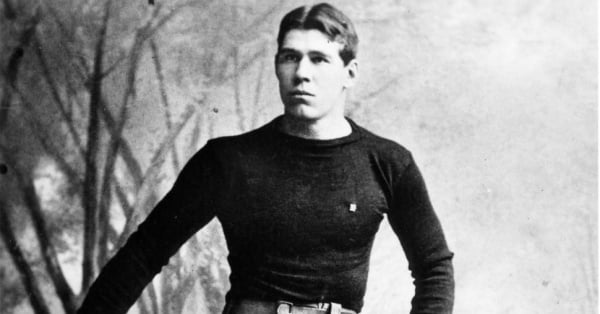Who Was William "Pudge" Heffelfinger
1/29/2019
The story of William “Pudge” Heffelfinger and the birth of professional football 120-plus years ago is now fairly well known. Heffelfinger was paid $500 to play one game for the Allegheny Athletic Association (AAA) on Nov. 12, 1892. He helped Allegheny defeat its archrival, the Pittsburgh Athletic Club, 4-0 and became the first known pro football player. However, not too many people know additional details about who Heffelfinger was as a person.

Through the Pro Football Hall of Fame’s important mission to “Honor the heroes of the game, preserve its history, promote its value and celebrate excellence everywhere,” the Ralph Wilson, Jr. Pro Football Research and Preservation Center staff has an opportunity to not only preserve and showcase the legacies of professional football players, coaches and contributors’ accomplishments in the game, but also who they are and what they believe.
William Walter Heffelfinger was born on Dec. 20, 1867 in Minneapolis. His father was in the shoemaking business and dabbled in real estate. “Pudge” played baseball and football at Central High School in Minneapolis before making his way to Yale University where he attended the school from 1888 to 1891.
His exceptional and natural athletic ability earned him legendary status on campus very quickly. Playing on both the offensive and defensive lines, Heffelfinger was named to Walter Camp’s All-American Team three times. Yale was a major football power during that time and Heffelfinger helped lead the team to undefeated seasons in 1888 and 1891 accompanying one-loss seasons in 1889 and 1890. The 1888 team amazingly outscored their opponents 698-0 that season (see its season results below).
Heffelfinger, at 6-foot-3 200 pounds, was especially big for that era and towered over his opponents. His size allowed him to wreak havoc on opposing lines where it was said he would typically take out two to three players at a time. He also is credited with introducing the “pulling guard” play. Famous sportswriter Grantland Rice once referred to Heffelfinger as the greatest guard of all-time. By the time his days at Yale had finished, “Pudge” not only lettered in football, but he also lettered in baseball, rowing, and track.
Following his days at Yale, Heffelfinger began a career in coaching where he made stops at the University of California, Lehigh University, and the University of Minnesota. He also frequently returned to Yale to help the football team prepare for contests against rivals Harvard and Princeton. In the 1930s, he founded Heffelfinger Publications which produced sales booklet for football and baseball equipment. He also spent time working for his father’s shoe business and later in the real estate business. Heffelfinger also went on to find success in politics. He was a Minnesota delegate to the Republican National Conventions in 1904 and 1908. He served as Hennepin (Minnesota) County Commissioner from 1924-48 and even ran, although unsuccessfully, for Congress in 1930.
“Pudge” maintained his playing shape throughout his life. Even in his 40s, it was common for him to return to Yale and the coach would give him a jersey and let him play with the second team during practice. In the early 1920s, he played in a pro game against the Columbus Panhandles which featured the famous Nesser brothers (certainly a story for another day). He continued as a regular in pro charity games up until his mid-60s. He played his last organized football game in a charity event in Minneapolis at the age of 65.
His fame as the game’s first documented professional player surfaced after his death. “Pudge,” who was inducted into the College Football Hall of Fame in 1951, died on April 2, 1954 at the age of 86. He was buried at the small Hawley Cemetery outside Blessing, Texas.
Go back to all blog listings

